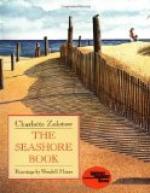[Illustration: PRECIOUS WENTLETRAP.]
The shell is built to fit the soft body. When a Periwinkle is hatched from the egg, it is as big as a pin’s head. It eats and grows, and the shell must therefore be made larger. So the mantle is stretched out, and it puts a film of lime to the edge of the shell. Bit by bit the shell is thus added to by the wonderful mantle. Look at a snail’s shell, and notice the lines which show how many times the little house has been made larger.
Each kind of shell-builder has its own style of building. If you go to a museum and examine the shells gathered from all over the world, you are surprised at their wonderful shapes, markings and colours. Another surprising thing is their size. Some are enormous, so large that they make good washing-basins. Others are so small that you can hardly see them. Each one was made by the folds of the mantle of the animal that lived in it.
In our coloured pictures you see many different kinds of shells, some of them built by uni-valve molluscs and some by bi-valve molluscs.
Wherever there are weeds along the shore you can find whole armies of the Periwinkle—the “Winkle” we all know so well. It browses there, among the weeds, just as its cousin, the land Snail, browses on your cabbages. You must have seen the little door with which the Periwinkle closes the entrance to his house. The land Snail does not own a door, but he makes one when he goes to sleep for the winter.
The Periwinkle crawls on a broad, slimy foot, which is put out from the shell. It is stretched on this side or that, and so draws him and his home in any direction. There are two sensitive feelers in front of his head; and behind these are two short stalks, on each of which is a tiny eye. If alarmed, the Periwinkle can shorten his body, and pull it back into its shell, closing the entrance with the horny door.
But the strangest part of him is the tongue. It is not for tasting, but for rasping. It is like a long, narrow ribbon, on which are hundreds of tiny points, all sloping backwards. They are arranged three in a row. The Periwinkle rasps the seaweed with his tongue, and so scrapes off his dinner. Of course the teeth wear away.
[Illustration: COWRIES.]
But only part of the toothed ribbon is used at a time, so there are plenty of teeth behind the worn ones, ready to take their place.
The shell, as we have seen, is made of limestone. But the teeth are made of flint. This is a hard substance, so hard that it is used for striking sparks.
Now we will look at a shell-builder, the Whelk, who uses his flinty tongue in quite another fashion. The Whelk does not care for a vegetable dinner. He prefers to eat other molluscs—he is carnivorous, a flesh-eater; but these other molluscs do not wait to be eaten. As the enemy draws near they retire into their shells, and shut themselves up as tight as they can. The Whelk, however, is a clever burglar; he knows how to make a way into the hardest of shelly houses.




